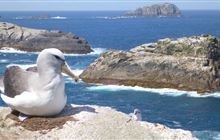Antipodean and Gibson's wandering albatross
Introduction
The Antipodean and Gibson's wandering albatross are one of the largest albatrosses with a wingspan of 3 metres. Gibson's wandering albatross looks very similar to Antipodean wandering albatross but usually have lighter plumage.Scientific name:
- Diomedea antipodensis antipodensis (Antipodean wandering albatross), and
- Diomedea antipodensis gibsoni (Gibson’s wandering albatross).
Population: Declining
New Zealand status: Endemic
Conservation status: Threatened–Nationally Critical
Primary Threats: Bycatch, marine pollution.
Species information: Antipodean albatross on NZ Birds Online
Basic information
Length: 110 cm
Weight: 4.5 to 8.5 kg
Antipodean wandering albatross population: 5,100 breeding pairs
Gibson's wandering albatross population: 7,400 breeding pairs
Food: fish, squid, and discards from fishing vessels
Distribution
The antipodean wandering albatross consists of two subspecies. The Antipodes island subspecies (D. a. antipodensis) breeds almost entirely on Antipodes Island and mainly forages over the shelf edge and deep water around the Chatham Rise during the breeding season. A few birds also visit the Tasman Sea. During non-breeding season, they can range as far east as coast of Chile.
The Auckland Island subspecies (D.a. gibsoni) breeds only in the Auckland Islands group, with most of the birds nesting on Adams Island. It forages mainly in the Tasman Sea.
Challenges
Challenges include:
- a limited understanding of the Antipodean wandering albatross population dynamics, and
- the high fisheries bycatch rate especially in waters beyond New Zealand's Exclusive Economic Zone (EEZ)
- sea surface temperature change caused by global warming. This has caused Antipodean wandering albatross to forage further north where they encounter dangerous fishing fleets in the high seas and get killed.
What we're doing to learn more
We have been doing long term monitoring of the breeding population to understand the population structure and dynamics.
We also recently developed a five-year plan of conservation actions for the Antipodean wandering albatross.
As part of the plan, we are working with Fisheries NZ to track 75 Antipodean wandering albatrosses in real-time to better understand their:
- distribution range
- where they forage, and
- when and where they are interacting with dangerous fishing fleets.
More about research and recovery of Antipodean wandering albatross.
How you can help
You can help by:
- letting DOC know if you find sick or injured albatrosses
- checking legs of dead albatrosses for metal leg bands
- reporting the band number or combination if you spot the birds during pelagic or fishing trips.
What to do if you find a banded bird and how to let DOC know


